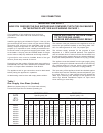
WATER PIPING
Pipes and fittings should be installed in compliance with the
installation drawing. Makes sure the dip tube is in the cold
water fitting and water connections are made correctly.
Have the installer show you where the water shut-off valve for
the water heater has been installed so that you know where
and how to shut the water off. It is recommended that such a
valve be located in close proximity to the cold water inlet of
the water heater. (See installation drawing, Figure 3).
Connect the cold water supply to the fitting marked “COLD”
the hot water outlet to the fitting marked “HOT”. Do not apply
heat to either of these fittings. It is imperative that no heat
be applied to these fittings as they contain a non-metallic
tube. When marking these connections, always use a good
grade of pipe joint compound and be certain that all fittings
are drawn up tight.
After piping has been installed, allow tank to fill up with water
and check connections for leaks. To ensure complete filling of
the tank, allow air to exit by opening the nearest hot water
faucet until a constant flow of water is obtained.
Check your area for water hardness. Hard water conditions
can shorten tank life or cause excessive maintenance. When
hard water conditions exist water softening is the best answer
to protect both the water heater and the appliances using hot
water.
Pressure Build-up in a Water System
During the heating cycle of the water heater, the water
expands, creating a pressure build-up in the water sys-
tem. The water supply meter may contain a check valve or
back-flow preventer, creating a closed water system. A
method of controlling thermal expansion would then be
required. Contact the water supplier or local plumbing
inspector for instructions to control the situation.
A temperature and pressure relief valve must be installed
on the water heater (150 p.s.i maximum pressure setting.
See Temperature and Pressure Relief Valve, below.)
Should the relief valve discharge water, a potentially
dangerous situation may be indicated and must be inves-
tigated. Have the operation of the heater checked by a
qualified service person.
Temperature and Pressure Relief Valve
For protection against excessive pressure and/or
temperatures, a temperature and pressure relief valve must
be installed in the opening marked “T&P VALVE” - a design
certified by a nationally recognized testing laboratory that
maintains periodic inspection of production of listed equipment
or materials, as meeting the requirements of Relief Valves and
Automatic Gas Shutoff Devices for Hot Water Supply
Systems, ANSI Z 21.22 - latest edition. Pressure rating of the
valve must not exceed the working pressure shown on the rat-
ing plate of the water heater. The discharge capacity must
be equal to or greater than the input to the water heater.
Water heaters intended to be shipped to Canadian
destinations may have the temperature and pressure relief
valve factory installed. Any replacement valve must meet the
latest edition of CAN 1-4.4, the Standard for “Temperature,
Pressure, Temperature and Pressure Relief Valves and
Vacuum Relief Valves.”
Relief valve piping must terminate 6 inches above a floor
drain or external to the building. Do not thread, cap or plug the
end of this discharge line. Be certain that no contact is made
with any live electrical part. Do not connect discharge line
directly to drain. See figure 3. To prevent bodily injury, hazard
to life or damage to property, the relief valve must be allowed
to discharge water in the event of excessive temperature or
pressure developing in the water heater. The function of the
temperature and pressure relief valve is to discharge water in
quantities should circumstances demand. If the discharge
pipe is not directed to a drain as shown in Figure 3 or other
suitable means, the water flow may cause property damage.
The discharge line:
1. Shall not be reduced by a coupling or any other restriction;
2. Must not be plugged, or blocked;
3. Must be of material capable of withstanding 210
o
F,
without distortion;
4. Must be installed so as to allow complete drainage of
both the temperature and pressure relief valve and dis-
charge lines;
5. Must terminate at an adequate drain; and
6. Must not have any valve installed between the relief
valve and the water heater.
Page 3
Failure to install and maintain a new,
properly listed temperature and
pressure relief valve will release the
manufacturer from any claims which may result
from excessive temperature or water pressure.
WARNING:
Do not attempt to operate this water heater
with the cold water inlet valve close.
Manually operate temperature and pressure
relief valve at least once a year. Standing
clear of the outlet, (discharge water will be
hot), lift and release the lever handle on the
temperature and pressure relief valve to
make sure the valve operates freely.
NEVER OPERATE THE HEATER IF IT IS NOT
COMPLETELY FILLED WITH WATER. TO
MAKE SURE THE HEATER IS FILLED, OPEN
THE HOT FAUCET OF TAP UNTIL A FULL
FLOW OF WATER IS VISIBLE WITH NO AIR
ESCAPING.


















